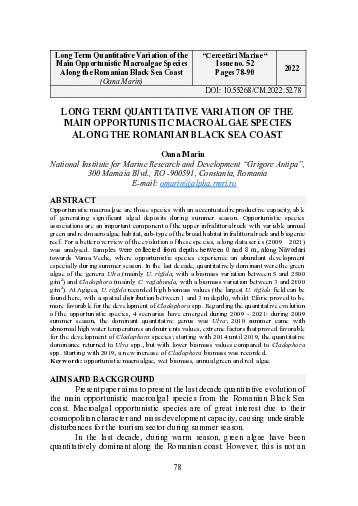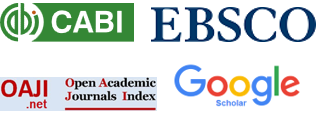Long Term Quantitative Variation of the Main Opportunistic Macroalgae Species Along the Romanian Black Sea Coast
DOI:
https://doi.org/10.55268/CM.2022.52.78Keywords:
opportunistic macroalgae, wet biomass, annual green and red algaeAbstract
Opportunistic macroalgae are those species with an accentuated reproductive capacity, able of generating significant algal deposits during summer season. Opportunistic species associations are an important component of the upper infralittoral rock with variable annual green and red macroalgae habitat, sub-type of the broad habitat infralittoral rock and biogenic reef. For a better overview of the evolution of these species, a long data series (2009 – 2021) was analysed. Samples were collected from depths between 0 and 8 m, along Năvodari towards Vama Veche, where opportunistic species experience an abundant development especially during summer season. In the last decade, quantitatively dominant were the green algae of the genera Ulva (mainly U. rigida, with a biomass variation between 5 and 2500 g/m2) and Cladophora (mainly C. vagabunda, with a biomass variation between 3 and 2800 g/m2). At Agigea, U. rigida recorded high biomass values (the largest U. rigida field can be found here, with a spatial distribution between 1 and 3 m depth), whilst Eforie proved to be more favorable for the development of Cladophora spp. Regarding the quantitative evolution of the opportunistic species, 4 scenarios have emerged during 2009 - 2021: during 2009 summer season, the dominant quantitative genus was Ulva; 2010 summer came with abnormal high water temperatures and nutrients values, extreme factors that proved favorable for the development of Cladophora species; starting with 2014 until 2019, the quantitative dominance returned to Ulva spp., but with lower biomass values compared to Cladophora spp. Starting with 2019, a new increase of Cladophora biomass was recorded.
Downloads
Published
How to Cite
Issue
Section
License
Copyright (c) 2025 Oana Marin

This work is licensed under a Creative Commons Attribution-NonCommercial-NoDerivatives 4.0 International License.
This is an open access journal, which means that all content is freely available without charge to the user or his/her institution. Users are allowed to read, download, copy, distribute, print, search, or link to the full texts of the articles, or use them for any other lawful purpose, without asking prior permission from the publisher or the author. This is in accordance with the BOAI definition of open access.






